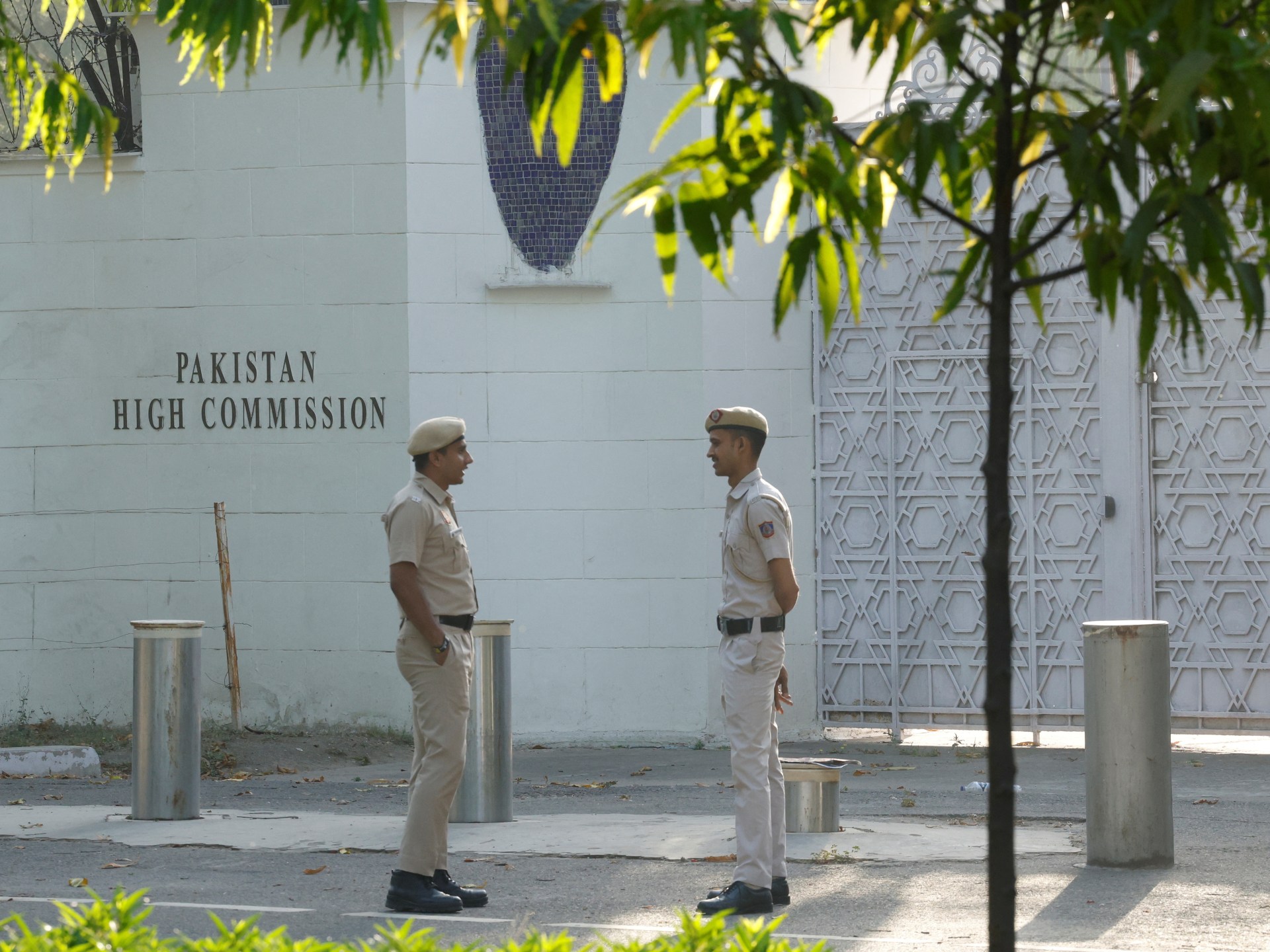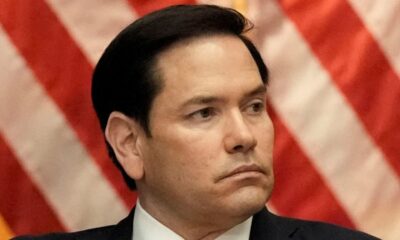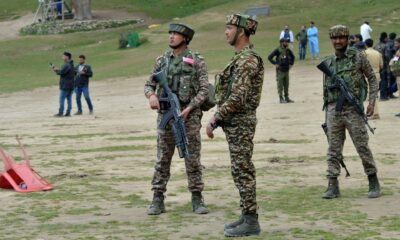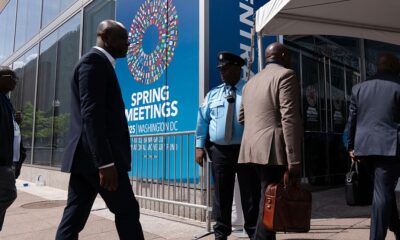Conflict Zones
Kashmir attack: Does India’s Indus Waters Treaty freeze threaten Pakistan? | Conflict News

In tit-for-tat moves this week, India and Pakistan have entered a strategic standoff following Tuesday’s attack on tourists in Pahalgam, Indian-administered Kashmir, which resulted in the deaths of at least 26 people.
On Wednesday, India downgraded ties with Pakistan, announcing a series of steps, the most important of which is a decision to suspend its participation in the Indus Waters Treaty (IWT), which could seriously restrict Pakistan’s water supplies.
India has also closed its main land border with Pakistan and given some Pakistani nationals currently in India a deadline to leave the country.
On Thursday, Pakistan retaliated with similar steps against India, and also threatened to suspend its participation in all bilateral agreements between the two, including the 1972 Simla Agreement, a peace accord drawn up following their war the previous year that led to the creation of Bangladesh.
Pakistan is particularly angered by the threat to the IWT and has warned India that any disruption to its water supply would be considered “an act of war”, adding that it was prepared to respond, “with full force across the complete spectrum of national power”.
The IWT, a transboundary water agreement that allows the two countries to share water flowing from the Indus basin, has survived armed conflicts and near-constant tensions between India and Pakistan over the past 65 years. While India came close to suspending the treaty in 2019, it did not go through with it.
Why has India taken action against Pakistan?
An armed group called The Resistance Front (TRF), which demands independence for Kashmir, has claimed responsibility for Tuesday’s attack in Pahalgam, one of Indian-administered Kashmir’s most popular tourist destinations. Indian authorities have previously claimed that TRF is an offshoot of the Lashkar-e-Taiba, an armed group based in Pakistan.
India has long held that Pakistan backs the armed rebellion in Kashmir, a charge Islamabad denies. On Wednesday, India claimed that the Pahalgam attack had “cross-border” linkages, blaming its western neighbour.
During a special briefing by the Indian Ministry of External Affairs on Wednesday, Foreign Secretary Vikram Misri said that the Cabinet Committee on Security (CCS) had been called to discuss the attack in which men armed with rifles killed 25 Indian tourists and one Nepalese tourist, all men.
“In the briefing to the CCS, the cross-border linkages of the terrorist attack were brought out,” Misri said.
Misri added: “The Indus Waters Treaty of 1960 will be held in abeyance with immediate effect until Pakistan credibly and irrevocably abjures its support for cross-border terrorism.” For a treaty to be in abeyance means that it is temporarily suspended or on hold.
Earlier on Thursday, India’s Prime Minister Narendra Modi said that India would identify, track and punish every “terrorist” and their backers.
What is the Indus Waters Treaty?
Signed in 1960, the origins of the IWT trace back to August 1947, when British colonial rule over the Indian subcontinent ended and India and Pakistan became two separate sovereign states. India is the upper riparian (located upstream) while Pakistan is the lower riparian, which means India has control over how the river flows.
Because both countries rely on the water from the Indus basin’s six rivers for irrigation and agriculture, they signed an agreement called the Standstill Agreement to continue allowing the flow of water across the border. When the Standstill Agreement expired in 1948, India stopped the water flow towards Pakistan from its canals, prompting an urgent need for negotiations on water sharing.
Following nine years of negotiations mediated by the World Bank, former Pakistani President Ayub Khan and former Indian PM Jawaharlal Nehru signed the IWT [PDF] in September 1960. The treaty gives India access to the waters of the three eastern rivers: the Ravi, Beas and Sutlej.
Pakistan, in turn, gets the waters of the three western rivers: the Indus, Jhelum and Chenab.
India can use the western rivers to generate hydroelectric power and for some limited agriculture, but cannot build infrastructure that restricts the flow of water from those rivers into Pakistan or redirects that water.

What would the suspension of this treaty mean for Pakistan?
It represents a threat from India that it could, if and when it chooses to, restrict the flow of water from the Indus, Jhelum and Chenab into Pakistan.
It does not mean that India plans to limit that flow immediately.
Even if it wanted to, it is unlikely that India could immediately stop the flow of water even though it has suspended its participation from the treaty.
This is because India has upstream reservoirs constructed on the western rivers, but their storage capacity cannot hold enough volumes of water to hold back water entirely from Pakistan. It is also high-flow season when ice from glaciers melts between May and September, keeping water levels high.
“The western rivers allocated to Pakistan carry very high flows, especially between May and September. India does not currently have the infrastructure in place to store or divert those flows at scale,” Hassaan F Khan, assistant professor of urban and environmental policy and environmental studies at Tufts University in the United States, told Al Jazeera.
However, if India were to try to stop – or cut – the water flow, Pakistan might feel the effects in seasons when water levels are lower. Pakistan relies heavily on the water from the western rivers for its agriculture and energy. Pakistan does not have alternative sources of water.
Pakistan has a largely agrarian economy, with agriculture contributing 24 percent to the country’s gross domestic product (GDP) and 37.4 percent to employment, according to Pakistan’s most recent economic survey published in 2024. The country’s statistics bureau says that the majority of the population is directly or indirectly dependent on the agriculture sector. According to the World Bank, the country’s current population is about 247.5 million.
Does India have the power to suspend this treaty?
While India has declared abeyance from the treaty, legal experts say that it cannot unilaterally suspend the treaty.
“India has used the word abeyance and there is no such provision to ‘hold it in abeyance’ in the treaty,” Ahmer Bilal Soofi, a Pakistani lawyer, told Al Jazeera. The treaty can only be modified by mutual agreement between the parties.
“It also violates customary international laws relating to upper and lower riparian where the upper riparian cannot stop the water promise for lower riparian,” Soofi said.
Anuttama Banerji, a political analyst based in New Delhi, told Al Jazeera that the treaty might continue, but not in its present form. “Instead, it will be up for ‘revision’, ‘review’ and ‘modification’ – all three meaning different things – considering newer challenges such as groundwater depletion and climate change were not catered for in the original treaty,” Banerji said.
“In principle, a unilateral suspension of a bilateral treaty can be challenged as a breach of international law,” Khan, the Tufts University assistant professor, told Al Jazeera.
However, the enforcement of this is complicated, Khan added. “The Indus Waters Treaty is a bilateral agreement without a designated enforcement body. While the World Bank has a role in appointing neutral experts and arbitrators, it is not an enforcement authority.”
Khan explained that if Pakistan wanted to pursue legal recourse, it would likely be through international forums such as the International Court of Justice (ICJ). “In practice, the main costs for India would be reputational and strategic: undermining its image as a rules-based actor, especially given its own status as a downstream riparian on other transboundary rivers.”
Khan said that the broader strategic goal of the IWT suspension seems to be a renegotiation of the treaty. “India has been signalling its desire to revise or renegotiate the treaty for some time,” he said, explaining that India had asked to renegotiate the treaty in January 2023 and again in September 2024, citing climate change and implementation challenges. Pakistan has so far refused.
“The recent announcement appears to be an attempt to apply pressure and force a renegotiation on terms more favourable to India. Whether this strategy succeeds remains to be seen, but it marks a significant departure from six decades of treaty stability.”
What other steps is India taking in response to the attack in Kashmir?
Besides the abeyance of the IWT, Mirsi announced other steps, including:
The main land border crossing between the two countries, the Integrated Check Post Attari, or the Attari-Wagah crossing, will be closed with immediate effect and those who have crossed over with “valid endorsements” have to return through the route before May 1.
Any SAARC Visa Exemption Scheme (SVES) visas granted to Pakistanis have been cancelled and any Pakistani currently visiting India on the SVES visa has to leave within 48 hours of the statement issued on Wednesday.
The military, naval and air advisers in the Pakistani High Commission in New Delhi are considered personae non gratae and have a week to leave India, while Indian military, naval and air advisers will be pulled back from the Indian High Commission in Islamabad. To be persona non grata in a country means to be unwelcome.
Five support staff members will also be pulled from each High Commission.
The staffing for each High Commission will be reduced from 55 members to 30 through further reductions by May 1.
How has Pakistan responded to India’s measures?
On Thursday, Pakistan’s Prime Minister Shehbaz Sharif called a high-level meeting of the National Security Committee (NSC).
A statement released by Sharif’s office on Thursday said: “the Committee reviewed the Indian measures announced on 23 April 2025 and termed them unilateral, unjust, politically motivated, extremely irresponsible and devoid of legal merit”.
The statement adds: “Pakistan vehemently rejects the Indian announcement to hold the Indus Waters Treaty in abeyance … Any attempt to stop or divert the flow of water belonging to Pakistan as per the Indus Waters Treaty … will be considered as an Act of War and responded with full force.
“Pakistan shall exercise the right to hold all bilateral agreements with India, including but not limited to Simla Agreement in abeyance, till India desists from its manifested behaviour of fomenting terrorism inside Pakistan; trans-national killings; and non-adherence to international law and UN Resolutions on Kashmir.”
The Simla Agreement was a peace treaty signed between Pakistan and India in 1972, which emphasised resolving conflict between the two countries peacefully and through bilateral negotiations.
On the same day, Pakistan also announced the closure of the Wagah border, suspended all visas under the SAARC Visa Exemption Scheme (SVES) issued to Indian nationals and declared Indian army and navy advisers in Islamabad personae non gratae.
Pakistan has also closed its airspace “with immediate effect” for all Indian owned or Indian operated airlines. It has also suspended all trade with India “including to and from any third country through Pakistan” – in effect saying that it won’t allow India to export to Afghanistan through its territory.
In the past, Pakistani officials have warned that India’s interference in water flow to Pakistan would be deemed an act of war, prompting retaliation.
In 2016, the then-chairman of Pakistan’s Senate, Raza Rabbani, said: “Interference with Pakistan’s water supply will be tantamount to an act of aggression and aggression will be met by aggression.”
Does this spell a major escalation in tensions between the two countries?
The suspension of the IWT is significant. While India has threatened to suspend it before, it has never actually gone through with its threat.
In 2016, suspected rebel fighters killed 17 Indian soldiers in the Uri area in Indian-administered Kashmir. Four suspected rebels were also killed by the Indian army during this attack. In the aftermath of the Uri attack, Modi said: “blood and water can’t flow together” when discussing the IWT with government officials. However, the IWT was not suspended after this.
In 2019, a suicide bomber killed 40 paramilitary police in Indian-administered Kashmir’s Pulwama. This attack was claimed by Jaish-e-Muhammad, an armed group based in Pakistan. In the aftermath, Indian Water Resources Minister Nitin Gadkari threatened to suspend the flow of water to Pakistan. However, this threat did not materialise.
Hence, India’s recent suspension of the treaty is the biggest escalation of its kind in the hydropolitics of the Indus basin.
Conflict Zones
Can South Africa help Russia and Ukraine reach a peace deal? | Russia-Ukraine war News

Pretoria, South Africa – As Ukrainian President Volodymyr Zelenskyy held talks with South African President Cyril Ramaphosa in Pretoria, the pro-Russia opposition condemned the visit while protesters gathered outside government buildings with a banner reading, “Shame on you, Ramaphosa and Zelenskyy.”
Zelenskyy cut short his first state visit to South Africa on Thursday, saying he would “return to Ukraine immediately” after overnight Russian attacks killed at least 12 people in Kyiv.
Since February 2022, Ukraine has been fending off a military onslaught by Moscow, aided by arms and support from allies in Europe and the United States.
Pretoria has remained neutral, calling for dialogue between both sides.
According to the Office of the United Nations High Commissioner for Human Rights, an estimated 12,910 civilians have been killed in Ukraine since the war started.
But South Africa’s main opposition political party, the uMkhonto weSizwe (MK) Party of former President Jacob Zuma, has taken aim squarely at Ukraine, blaming it for the current crisis.
“The MK Party strongly condemns Mr Ramaphosa’s misguided decision to extend an invitation to Volodymyr Zelenskyy, a figure widely discredited among progressive and nonaligned nations,” Floyd Shivambu, the secretary-general of the MK said earlier this month when the visit was announced.
Zelenskyy, Shivambu said, was the “puppet” president of NATO and the West and someone who “sought to destabilise Eastern Europe and the entire world”.
“We think [Zelenskyy] is the cause of the war between Russia and Ukraine. He provoked Putin,” Magazela Mzobe, a senior aide to Zuma, told Al Jazeera this week, urging protests.
“We regard Russia and President Putin as our friends.”
Zuma previously claimed that NATO countries instigated the “crisis” in Ukraine in a bid to counteract the BRICS alliance – a group of large developing world economies that includes Russia and South Africa.
South Africa, a historical ally of Russia mainly due to the support the former Soviet Union provided antiapartheid and decolonial movements in Africa, has not condemned Russia or Putin, has abstained from a United Nations resolution doing so and has maintained good ties with Moscow.

Put ‘strong pressure on Russia’
Days before meeting with Zelenskyy, Ramaphosa had a telephone call with Putin in which, he said, the two “committed to working together towards a peaceful resolution of the Russia-Ukraine conflict”.
Hours before meeting Zelenskyy on Thursday, Ramaphosa said he had also spoken with US President Donald Trump and the two agreed that the war in Ukraine needed to stop.
Ukraine faces ongoing pressure to accept stringent US conditions for a peace deal.
On Wednesday, Trump had chastised Zelenskyy for rejecting a Trump administration proposal that would see him cede Crimea to Russia.
After Thursday’s talks with Ramaphosa, in which the leaders discussed improving trade as well as ending the war, Zelenskyy said that while Ukraine is open to an unconditional ceasefire, pressure needed to be put on Moscow because it was up to Russia to halt attacks.
“We do not see signs of the US putting strong pressure on Russia as part of its peace push,” he told journalists in Pretoria. Zelenskyy said a new set of proposals was on Trump’s desk after talks on Wednesday in London.
When pushed about what he would be willing to compromise on during peace talks, Zelenskyy said he was ready to abide by what was proposed but could not go against the Ukrainian Constitution.
“It is already a big compromise on Ukraine’s part to agree to sit down with Russia once a ceasefire is in place,” he said.
If an unconditional ceasefire is enforced, the question remains who would be a guarantor of it. Zelenskyy said it should be a NATO country that is strong enough to withstand Russia. Ramaphosa said South Africa and other African countries stood ready to be a guarantor to ensure peace.
Against the backdrop of Zelenskyy’s visit, some questioned why South Africa would want to help broker peace – and what role it could play.

Does South Africa have influence?
South African Foreign Affairs Minister Ronald Lamola says his country is well placed to mediate between Russia and Ukraine because of its history successfully negotiating an end to apartheid, as well as its role in mediating conflicts across Africa.
“We don’t believe funding wars resolves conflict. We believe talks end wars. We can’t out-gun our way out of conflict,” his spokesperson Chrispin Phiri told Al Jazeera.
However, political analysts watching developments are not all convinced Pretoria has a role to play or whether its efforts could even help yield the desired peace outcomes.
“The Americans and Russians are discussing. And this discussion is very resistant to the allies of the Americans, the Europeans. They have not been involved. They have been fighting to get around the table,” said political analyst Kingsley Makhubela from the University of Pretoria.
“I don’t understand what value South Africa will have if the Europeans who have a direct interest in the resolution of the conflict have no influence around this.”
Makhubela said he was concerned about South Africa possibly being pulled between the interests of the US and the European Union in resolving the Ukraine war.
“We must not play into the hands of either party.”
Makhubela told Al Jazeera he did not believe Pretoria could persuade either the Russians or Ukrainians to commit to peace talks.
“I don’t know what South Africa’s strengths are to influence this process,” he said.
Regarding the opposition’s calls to protest Zelenskyy’s visit, Makhubela said they were not extraordinary.
“Internally, you will find groups from the far left and the far right will pronounce why they are against this visit,” he said.
The opposition MK Party, which protested Zelenskyy’s visit, also argued South Africa is ill-equipped to effectively negotiate peace between Ukraine and Russia.
However the MK itself – a breakaway faction from the African National Congress (ANC), the majority party in South Africa’s coalition government – has faced accusations of receiving Russian money.
Last year, John Steenhuisen – the leader of the Democratic Alliance (DA), the second-largest party in the governing coalition – accused the MK Party of being financially backed due to its links to Putin although he admitted there was no definitive proof. “I’m certain that money has flown into their accounts from Russia,” he remarked to the Financial Mail newspaper.
The MK denied the allegations of financial connections but has acknowledged the longstanding relationship between Zuma and Putin.
“President Zuma and President Putin have enjoyed a relationship that goes back 40 years. They’re friends. But that’s not the same as the Russian government supporting the MK Party,” party spokesperson Nhlamulo Ndlela said last year.
The MK Party’s affinity for Putin is no secret; it even markets regalia adorned with images of both Zuma and Putin. Zuma has also repeatedly sought medical treatment in Russia during and after his presidency. Additionally, he has faced allegations of corruptly securing a now-defunct nuclear deal with Russia during his time in office.
Nonetheless, the MK Party insisted its protest against Zelenskyy’s visit is unrelated to its leader’s close ties with Putin.

Ukraine ‘a democracy’ like South Africa
Despite the pushback to Zelenskyy from some quarters, the Ukrainian Association of South Africa (UAZA), represented by Dzvinka Kachur, was unfazed by the protests and opposition to his visit.
“South Africa, like Ukraine, is a democracy. In Russia, you cannot protest. If you go to the street, you will be arrested or you will disappear,” Kachur said.
The UAZA, representing about 1,000 Ukrainians residing in South Africa, advocates for improved communication between the two nations.
It has previously expressed criticism about the South African government’s failure to openly condemn Russia’s invasion of Ukraine, notably by abstaining from a UN vote.
The South African government has maintained its stance of nonalignment and is seeking to facilitate mediation in the conflict with Russia.
Speaking at a joint news conference with Zelenskyy on Thursday, Ramaphosa called upon both Russia and Ukraine to ensure there is a comprehensive ceasefire so negotiations can start.
He said South Africa believed the only path to peace is through diplomacy, inclusive dialogue and a commitment to the principles of the UN Charter.
He also expressed deep concern about the continuing conflict in Ukraine, the loss of civilian lives, damage to critical infrastructure and the deteriorating humanitarian situation.
Kachur told Al Jazeera that any attempt by Ramaphosa to broker peace between Russia and Ukraine would be contingent upon significant actions by Russia.
“A peaceful solution is only possible if Russia’s colonial system reforms,” she asserted, meaning Russia should stop taking Ukrainian territory. “If there is no change inside Russia, there can’t be peace.”
In Ramaphosa’s phone conversation with Putin before Zelenskyy’s visit, the Russian leader articulated his country’s position on the necessity of addressing the “root causes” of the conflict and ensuring Russia’s security interests, according to the Kremlin.
“South Africa will continue engaging all interested and affected parties, including the government of Ukraine, in finding a path to peace,” the South African Presidency said after the call.
But as pressure from the Trump administration mounts for an end to the war, the dichotomy between South African government neutrality, the main opposition’s staunch support for Russia and the host of international actors wanting a seat at the table leaves uncertainty as to the real role Pretoria could play.
Conflict Zones
Al-Shabab battles Somalia’s army for strategic military base | Conflict News

The armed group says it seizes control of Wargaadhi town and its military base, but the Somali army denies the claim.
Al-Shabab fighters have battled Somali troops and allied forces for control of a strategic army base in southern Somalia, according to the government and a military official.
Capturing the base in Wargaadhi town in the Middle Shabelle region, which houses soldiers, special forces and clan fighters, would enable the al Qaeda-linked group to sever a crucial road between the capital, Mogadishu, 200km (124 miles) to the southwest, and the central Galmudug State as it tries to extend recent gains made in the region.
Al-Shabab has been fighting the Somali government for more than 16 years and frequently targets government officials and military personnel. It said in a statement that its fighters had captured the base and Wargaadhi town – a claim the government denied.
The Ministry of Information said in a statement that government forces had killed more than 40 people after they tried to attack the base on Thursday morning.
However, army officer Hussein Ali told the news agency Reuters that the armed group had taken the town of Wargaadhi after “fierce fighting”.
“Our forces lost 12 men, mostly [clan fighters]. Around 20 al-Shabab fighters were also killed,” Ali said. “But finally al-Shabab got more reinforcements and managed to capture the town.”
He added that Somalia’s military was struggling to send reinforcements because it would need to use routes passing through al-Shabab-held areas.
Two soldiers quoted by Reuters said government forces, backed by air strikes, had managed to recapture part of the town by midmorning.
It was not possible to independently verify the claims made by either side.
Ongoing offensive
Last week, al-Shabab claimed to have seized control of nearby Adan Yabal, a town and logistical hub for government forces about 220km (130 miles) north of Mogadishu.
However, Captain Hussein Olow, a military officer in Adan Yabaal, denied the report, telling Reuters government troops had pushed the group back.
Both attacks are part of an offensive launched by al-Shabab last month. The group briefly captured villages within 50km (30 miles) of Mogadishu, raising fears among the capital’s residents that the city could be targeted.
While Somali forces have since recaptured those villages, al-Shabab has continued to advance in the countryside as the future of international security support to Somalia appears increasingly precarious.
A new African Union peacekeeping mission, the AU Support and Stabilization Mission in Somalia, replaced a larger force in February, but its funding is uncertain as the United States remains opposed to transitioning to a United Nations financing model.
Conflict Zones
How will Harvard and other universities survive Trump’s funding cuts? | Conflict News

On Monday, Harvard University sued US President Donald Trump’s administration to halt the freezing of $2.3bn in federal funding for the institution. The funding freeze came amid US government efforts to crack down on student protesters and pressure universities into dropping diversity, equity and inclusion programmes.
On March 10, the US Department of Education announced it had sent letters to 60 higher education institutions, warning them of “enforcement actions” if they did not protect Jewish students on campus as stipulated in the Title VI of the Civil Rights Act. The letters also quoted Secretary of Education Linda McMahon saying, “US colleges and universities benefit from enormous public investments funded by US taxpayers. That support is a privilege and it is contingent on scrupulous adherence to federal anti-discrimination laws.”
Shortly after, the Trump administration began freezing federal funding for some of the country’s top institutions, threatening research that universities say is critical for medical and scientific advancement.
In particular, the Trump administration is targeting institutions where students participated in pro-Palestine protests last year, alleging that the student protesters spread anti-Semitic sentiment on campus.
A day after Harvard filed its lawsuit, leaders and representatives of more than 200 American universities issued a joint statement accusing the Trump administration of political interference. The statement was signed by presidents and directors of some of the top-tier institutes in the country, including Princeton, Brown, Harvard, Columbia, Northwestern University and Pomona College.
So, what is going on in terms of federal funding on US campuses, and can universities survive these cuts?
Why is Harvard suing the US government over funding?
On April 11, the US Department of Education, Department of Health and Human Services, and the General Services Administration co-signed a letter to Harvard claiming that “Harvard has in recent years failed to live up to both the intellectual and civil rights conditions that justify federal investment.”
The letter made a series of demands of the university, including that the institution end all affirmative action in faculty hiring and student admissions, and that it change its admissions criteria to exclude international students “hostile to the American values”, including “students supportive of terrorism or anti-Semitism”. This was a follow-up to a separate letter the government had sent Harvard on April 3, demanding that the university reform any academic departments deemed to be fuelling “antisemitic harassment”. These departments, the letter said, “must be reviewed and necessary changes made to address bias, improve viewpoint diversity, and end ideological capture”.
In response, Harvard rejected the demands, saying that while some demands were aimed at targeting anti-Semitism, “the majority represent direct governmental regulation of the ‘intellectual conditions’ at Harvard.”
Hours after Harvard rejected the demands, an Education Department task force to tackle anti-Semitism released a statement announcing that $2.3bn in federal funding to the university had been frozen.
Harvard’s president, Alan Garber, and fellows of Harvard College have now filed a lawsuit (PDF) in the US District Court in Massachusetts against leaders of the US Department of Education, Department of Health and Human Services, General Services Administration, Department of Energy, Department of Defense, National Science Foundation and National Aeronautics and Space Administration.
In a statement issued on Monday, Garber wrote: “We filed a lawsuit to halt the funding freeze because it is unlawful and beyond the government’s authority.”
The suit says that “the federal Government has launched a broad attack on the critical funding partnerships” which make it possible for Harvard and other American universities to carry out “invaluable research” in the fields of medicine, engineering and artificial intelligence (AI) which is crucial for finding solutions for space travel and for the diagnosis and treatment of diseases such as Parkinson’s, Alzheimer’s and cancer, among other things.
The lawsuit also alleges that the funding freeze is unlawful because it infringes on First Amendment rights, which guarantee the freedom of speech.
“This case involves the Government’s efforts to use the withholding of federal funding as leverage to gain control of academic decision-making at Harvard,” the lawsuit states.
The Tuesday joint statement co-signed by hundreds of American university leaders states: “We will always seek effective and fair financial practices, but we must reject the coercive use of public research funding.”
How much money could Harvard and other universities lose?
The frozen federal funds to Harvard include $2.2bn in grants and $60m in contracts. However, more money is at stake. In March, the Trump administration announced that it would review $9bn of funding to Harvard.
The administration has also threatened to revoke Harvard’s tax exempt status and its ability to enrol foreign students. In the Monday statement, Garber also wrote that the Trump administration has considered taking steps to freeze an additional $1bn in grants.
In February, the Trump administration froze $400m of funding to Columbia University, which emerged as the epicentre of pro-Palestine campus protests in 2024. The government cited what it called the institution’s “failure to protect Jewish students from anti-Semitic harassment”.
On March 19, Trump froze more than $175m in federal funding to his alma mater, the University of Pennsylvania, citing the allowance of transgender women to play women’s sports.
How else is university funding being targeted?
Some universities have reported receiving “stop work” orders, which are instructions to suspend all work on specific research projects supported by public funding.
“American universities receive two main funding sources from the federal government. The first is financial aid for students, which flows to thousands of colleges. The second is research funding, which is heavily concentrated at about 200 universities,” Robert Kelchen, a professor and department head at the Department of Educational Leadership and Policy Studies at the University of Tennessee, Knoxville, told Al Jazeera.
“The American government has relied on universities to conduct research to benefit the country since World War II, and universities have built an infrastructure around that. The magnitude of American research funding has been unmatched around the world during this period,” said Kelchen.
Cornell University said it had received more than 75 “stop work” orders from the US Department of Defense, according to a statement released by Cornell President Michael I Kotlikoff and other university leaders on April 8.
The orders sent to Cornell relate to “research into new materials for jet engines, propulsion systems, large-scale information networks, robotics, superconductors, and space and satellite communications, as well as cancer research”, the university said.
The statement did not specify the amount of federal funding the projects subject to stop work orders were receiving. It also did not say why the government had issued these orders.
Northwestern University has also received stop work orders relating to roughly 100 federal grants, the university’s President Michael Schill and Chair of Board of Trustees Peter Barris wrote in a statement on Northwestern University’s website on April 17.
Earlier in April, US media outlets reported that the Trump administration had separately frozen more than $1bn in federal funding to Cornell University and $790m in funding to Northwestern University. The New York Times and CNN both claimed that an unnamed White House official had confirmed these funding freezes. “The money was frozen in connection with several ongoing, credible, and concerning Title VI investigations,” the official was quoted by CNN as saying.
However, both Cornell and Northwestern say they have not received notification of these funding freezes.
How much money of their own do universities have?
Many universities have sizeable endowment funds from which they can draw income each year to support research projects, scholarships and other expenses. An endowment is a series of funds or assets donated to a university to ensure that the institution is financially sustained in the future. Charitable donations from alumni, other donors and companies make up a huge part of endowments.
Harvard’s endowment was worth approximately $53.2bn in the 2024 fiscal year – the largest of any university. More than one-third of the research at Harvard is funded directly by the university, according to Harvard’s website.
Columbia’s endowment was $14.8bn for the fiscal year ending in June 2024. Cornell’s endowment was about $10.7bn in the fiscal year ending in June 2024. Northwestern University’s endowment amounted to approximately $14.3bn in 2024. University of Pennsylvania’s endowment was $22.3bn as of June 2024.
Some universities will be able to fall back on these endowments if federal funding freezes remain in place. “Universities typically spend about 5 percent per year out of their endowment, which provides funding for the Harvards of the world to make up for a loss of federal funding,” said Kelchen.
Endowments are subject to restrictions, however. “Endowment funds are heavily concentrated at a few dozen universities, and roughly three-fourths of all endowment funds are restricted for particular purposes,” Kelchen said, explaining that such purposes include student scholarships in very specific fields.
At Harvard, donors decide which programmes, departments and purposes 70 percent of the annual endowment distribution is spent on. Columbia’s website also states that the annual spending of the endowment is according to the wishes of the donors.
Universities have also seen a fall in the value of endowments. In 2024, Harvard’s donations dropped by $151m after some donors pulled funding from the university over the pro-Palestine protests and the university’s response to concerns about anti-Semitism on campus, according to an October 2024 report by the student-run newspaper, the Harvard Crimson.
How will universities respond to threats to government funding?
Kelchen said that a few research universities may be able to make it through a period of several years without federal funding.
In its April 17 statement, for example, Northwestern University’s leadership wrote that for now, the university will continue to fund the research projects that are subject to stop work orders from the government. “This support is intended to keep these projects going until we have a better understanding of the funding landscape.”
Most universities will not be able to afford to this. Some, therefore, are acceding to government demands.
After receiving its own list of demands from the government on March 13, Columbia, for example, accepted these demands on March 18 and introduced new policies on campus. These new policies require protesting students to present their university identification if asked to do so. They also prohibit face masks intended to conceal a person’s identity. However, face coverings are still allowed for religious or medical reasons. Columbia also hired 36 security officers who have special powers to arrest students, and the university continues to rely on New York police for additional security assistance.
Some universities will try to seek other sources of funding, experts say.
“Universities have been trying to diversify funding sources for years. The two most likely sources are increasing enrolment [to get more tuition dollars] and trying to generate more donations,” said Kelchen.
“Some universities have the physical capacity to increase enrolment, while others do not. And universities are hoping for a rush of donations to help them get through a difficult time,” said Kelchen.
-

 Europe2 days ago
Europe2 days agoRubio to skip Ukraine talks as Zelensky rejects key detail of US ceasefire proposal
-

 Conflict Zones2 days ago
Conflict Zones2 days agoManhunt under way in Kashmir after deadly attack on tourists | Conflict News
-

 Conflict Zones1 day ago
Conflict Zones1 day agoWhite and Black farmers still bear the scars of Zimbabwe’s land grabs | Poverty and Development News
-

 Africa2 days ago
Africa2 days agoTrade uncertainty could worsen global economic challenges, IMF warns
-

 Sports2 days ago
Sports2 days agoLA Lakers level first-round series against Minnesota Timberwolves behind big Luka Dončić performance
-

 Lifestyle1 day ago
Lifestyle1 day agoNFL draft suits give prospects another way to cash in on their fame, flash their style on red carpet
-

 Middle East2 days ago
Middle East2 days agoMagnitude 6.2 earthquake jolts Turkiye’s Istanbul | News
-

 Europe2 days ago
Europe2 days agoRussians are still traveling around Europe despite sanctions. Not everyone’s happy about it




